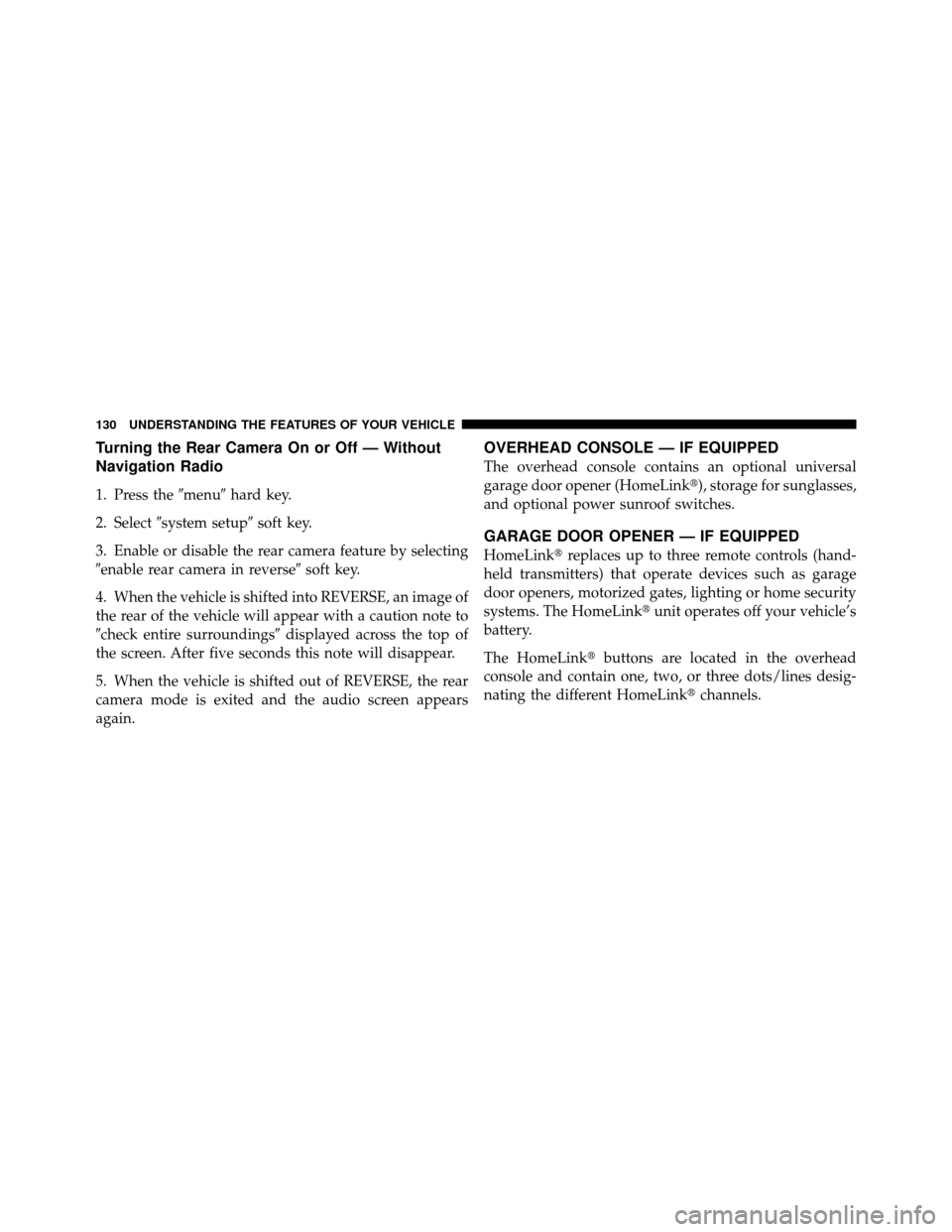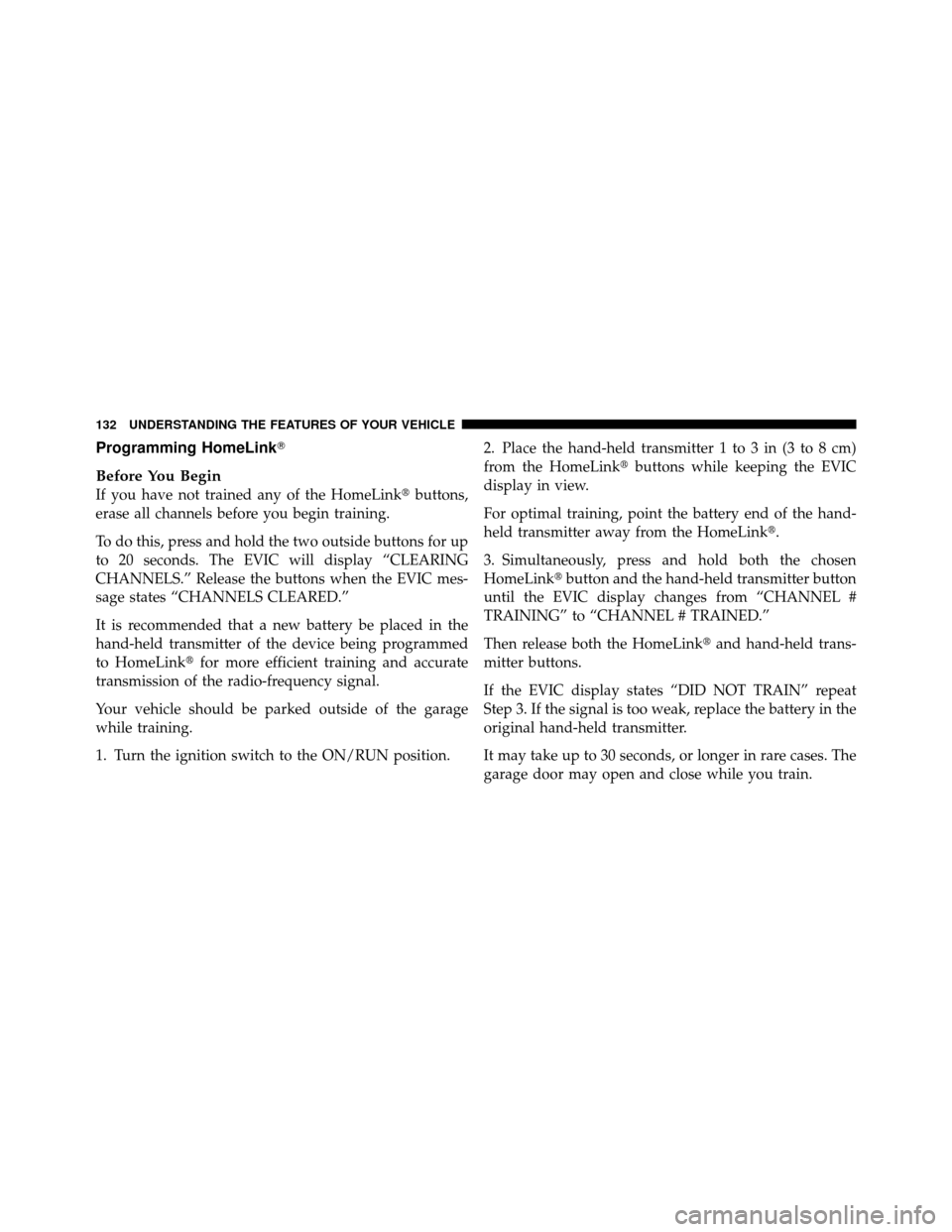Page 79 of 460

▫Battery Saver Feature — Exterior/Interior
Lights ............................ 110
▫ Lights-On Reminder .................. 110
▫ Turn Signals ........................ 110
▫ Lane Change Assist ....................111
▫ High/Low Beam Switch ................111
▫ Flash-To-Pass ........................111
▫ Headlight Off Delay ...................111
▫ Interior Lights .......................111
▫ Courtesy/Reading Lights ...............111
� Windshield Wipers And Washers .......... 112
▫ Windshield Wiper Operation ............ 113
▫ Windshield Washer Operation ........... 113▫
Mist ............................. 114
▫ Intermittent Wiper System .............. 114
▫ Rain Sensing Wipers — If Equipped ....... 115
� Tilt/Telescoping Steering Column .......... 117
� Adjustable Pedals — If Equipped .......... 117
� Electronic Speed Control — If Equipped ..... 119
▫ To Activate ......................... 120
▫ To Set a Desired Speed ................ 120
▫ To Deactivate ....................... 121
▫ To Resume Speed .................... 121
▫ To Vary The Speed Setting .............. 121
▫ To Accelerate For Passing .............. 121
3
UNDERSTANDING THE FEATURES OF YOUR VEHICLE 79
Page 110 of 460

Battery Saver Feature — Exterior/Interior Lights
If the multifunction lever is left in the interior light
position, parking light position, or the headlight position
when the ignition switch is moved to the OFF position,
the battery saver feature will automatically turn off the
exterior and interior lights after eight minutes. Normal
operation will resume when the ignition is turned ON or
when the headlight switch is turned to another position.
Lights-On Reminder
If the headlights or parking lights are on after the ignition
is turned OFF, a chime will sound when the driver’s door
is opened.
Turn Signals
Move the multifunction lever up or down and the arrows
on each side of the instrument cluster flash to show
proper operation of the front and rear turn signal lights.NOTE:
If either light remains on and does not flash, or
there is a very fast flash rate, check for a defective outside
light bulb. If an indicator fails to light when the lever is
moved, it would suggest that the indicator bulb is
defective.
Turn Signal Control
110 UNDERSTANDING THE FEATURES OF YOUR VEHICLE
Page 130 of 460

Turning the Rear Camera On or Off — Without
Navigation Radio
1. Press the�menu�hard key.
2. Select �system setup� soft key.
3. Enable or disable the rear camera feature by selecting
�enable rear camera in reverse� soft key.
4. When the vehicle is shifted into REVERSE, an image of
the rear of the vehicle will appear with a caution note to
�check entire surroundings� displayed across the top of
the screen. After five seconds this note will disappear.
5. When the vehicle is shifted out of REVERSE, the rear
camera mode is exited and the audio screen appears
again.
OVERHEAD CONSOLE — IF EQUIPPED
The overhead console contains an optional universal
garage door opener (HomeLink�), storage for sunglasses,
and optional power sunroof switches.
GARAGE DOOR OPENER — IF EQUIPPED
HomeLink� replaces up to three remote controls (hand-
held transmitters) that operate devices such as garage
door openers, motorized gates, lighting or home security
systems. The HomeLink� unit operates off your vehicle’s
battery.
The HomeLink� buttons are located in the overhead
console and contain one, two, or three dots/lines desig-
nating the different HomeLink� channels.
130 UNDERSTANDING THE FEATURES OF YOUR VEHICLE
Page 132 of 460

Programming HomeLink�
Before You Begin
If you have not trained any of the HomeLink�buttons,
erase all channels before you begin training.
To do this, press and hold the two outside buttons for up
to 20 seconds. The EVIC will display “CLEARING
CHANNELS.” Release the buttons when the EVIC mes-
sage states “CHANNELS CLEARED.”
It is recommended that a new battery be placed in the
hand-held transmitter of the device being programmed
to HomeLink� for more efficient training and accurate
transmission of the radio-frequency signal.
Your vehicle should be parked outside of the garage
while training.
1. Turn the ignition switch to the ON/RUN position. 2. Place the hand-held transmitter 1 to 3 in (3 to 8 cm)
from the HomeLink�
buttons while keeping the EVIC
display in view.
For optimal training, point the battery end of the hand-
held transmitter away from the HomeLink�.
3. Simultaneously, press and hold both the chosen
HomeLink� button and the hand-held transmitter button
until the EVIC display changes from “CHANNEL #
TRAINING” to “CHANNEL # TRAINED.”
Then release both the HomeLink� and hand-held trans-
mitter buttons.
If the EVIC display states “DID NOT TRAIN” repeat
Step 3. If the signal is too weak, replace the battery in the
original hand-held transmitter.
It may take up to 30 seconds, or longer in rare cases. The
garage door may open and close while you train.
132 UNDERSTANDING THE FEATURES OF YOUR VEHICLE
Page 136 of 460

Troubleshooting Tips
If you are having trouble programming HomeLink�, here
are some of the most common solutions:
•Replace the battery in the original transmitter.
•Press the learn button on the garage door opener to
complete the training for rolling code.
•Did you unplug the device for training and remember
to plug it back in?
If you are having any problems or require assistance,
please call toll-free 1–800–355–3515 or, on the Internet at
www.HomeLink.com for information or assistance.
General Information
This device complies with FCC rules Part 15 and Industry
Canada RSS-210. Operation is subject to the following
two conditions:
1. This device may not cause harmful interference. 2. This device must accept any interference that may be
received including interference that may cause undesired
operation.
NOTE:
The transmitter has been tested and it complies
with FCC and IC rules. Changes or modifications not
expressly approved by the party responsible for compli-
ance could void the user ’s authority to operate the
device.
The term “IC:” before the certification/registration num-
ber only signifies that Industry Canada technical specifi-
cations were met.
136 UNDERSTANDING THE FEATURES OF YOUR VEHICLE
Page 140 of 460
NOTE:Hold onto shade handle until shade is com-
pletely open or closed.ELECTRICAL POWER OUTLETS
Your vehicle is equipped with 12 Volt power outlets that
can be used to power cellular phones, small electronics
and other low powered electrical accessories. The power
outlets are labeled with either a “key” or a “battery”
symbol to indicate how the outlet is powered. Power
outlets labeled with a “key” are powered when the
ignition switch is in the ON or ACC position, while the
outlets labeled with a “battery” are connected directly to
the battery and powered at all times.
NOTE:
•Do not exceed the maximum power of 160 Watts (13
Amps) at 12 Volts for either of these outlets.
•All accessories connected to the “battery” powered
outlets should be removed or turned off when the
vehicle is not in use to protect the battery against
discharge.Roller Shade
140 UNDERSTANDING THE FEATURES OF YOUR VEHICLE
Page 142 of 460

WARNING!
To avoid serious injury or death:
•Do not insert any objects into the receptacles.
•Do not touch with wet hands.
•Close the lid when not in use and while driving
the vehicle.
•If this outlet is mishandled, it may cause an
electric shock and failure.
CAUTION!
•Many accessories that can be plugged in draw
power from the vehicle’s battery, even when not in
use (i.e., cellular phones, etc.). Eventually, if
plugged in long enough, the vehicle’s battery will
discharge sufficiently to degrade battery life
and/or prevent the engine from starting.(Continued)
CAUTION! (Continued)
•Accessories that draw higher power (i.e., coolers,
vacuum cleaners, lights, etc.) will degrade the
battery even more quickly. Only use these inter-
mittently and with greater caution.
•After the use of high power draw accessories, or
long periods of the vehicle not being started (with
accessories still plugged in), the vehicle must be
driven a sufficient length of time to allow the
generator to recharge the vehicle’s battery.
142 UNDERSTANDING THE FEATURES OF YOUR VEHICLE
Page 150 of 460

Rear Window Defroster
The rear window defroster button is located on the
climate control panel. Press this button to turn on
the rear window defroster and the heated outside mirrors
(if equipped). An indicator in the button will illuminate
when the rear window defroster is on. The rear window
defroster automatically turns off after approximately
10 minutes. For an additional five minutes of operation,
press the button a second time.
NOTE: To prevent excessive battery drain, use the rear
window defroster only when the engine is operating.
CAUTION!
Failure to follow these cautions can cause damage to
the heating elements:
(Continued)
CAUTION! (Continued)
•Use care when washing the inside of the rear
window. Do not use abrasive window cleaners on
the interior surface of the window. Use a soft cloth
and a mild washing solution, wiping parallel to
the heating elements. Labels can be peeled off
after soaking with warm water.
•Do not use scrapers, sharp instruments, or abra-
sive window cleaners on the interior surface of the
window.
•Keep all objects a safe distance from the window.
ROOF LUGGAGE RACK — IF EQUIPPED
The crossbars and siderails are designed to carry the
weight on vehicles equipped with a luggage rack. The
load must not exceed 150 lbs (68 kg), and should be
uniformly distributed over the luggage rack crossbars.
150 UNDERSTANDING THE FEATURES OF YOUR VEHICLE